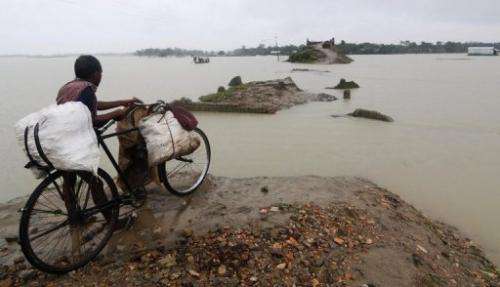Warming places SE Asia, India at higher risk of flood

Rising carbon emissions will place parts of India, China, Southeast Asia, East Africa and the northern Andes at a higher risk of extreme floods, a study published on Sunday says.
Global warming will boost the frequency at which exceptional floods occur in these regions, while eastern Europe, parts of Scandinavia, Chile and Argentina will have fewer such events, it suggests.
The estimates are based on 11 models for greenhouse-gas emissions and their impact on 29 river basins by 2100.
At the extreme end of the estimate range—if temperatures rise by four or five degrees Celsius (seven or nine degrees Fahrenheit)—a flood event that statistically occurred only once every one hundred years in the 20th century could return every 10 to 50 years in the most vulnerable locations.
"Many of these regions are already notorious for (being) flood-prone," said Shinjiro Kanae, a civil engineer at the Tokyo Institute of Technology, who took part in the modelling.
The "return period" of once-a-century floods reduces if warming levels by 2100 are lower, though.
The study, published in the journal Nature Climate Change, is led by Yukiko Hirabayashi of the University of Tokyo.
It is one of the most ambitious attempts to finetune estimates on where flooding will occur in a warmer world. Previous studies have used only several models, or even just one, which means the range of uncertainty is very wide.
The Japanese authors note that there remains a large margin of regional variability in their estimates. They also point out that the estimates do not take into account actions that worsen or prevent flooding.
UN members have pledged to limit warming to 2C (3.6 F) compared to pre-industrial temperatures.
But the current rise in carbon concentrations is in line with 4C or 5C (7-9 F) by 2100, a figure that many scientists say would be catastrophic for biodiversity and for hundreds of millions exposed to hunger, extreme weather or sea-level rise.
More information: dx.doi.org/10.1038/nclimate1911
Journal information: Nature Climate Change
© 2013 AFP


















